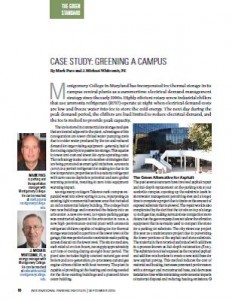 By Mark Pace and J. Michael Whitcomb, PE
By Mark Pace and J. Michael Whitcomb, PE
Montgomery College in Maryland has incorporated ice thermal storage in its campus central plants as a summertime electrical demand management strategy since the early 1990s. Highly efficient rotary screw industrial chillers that use ammonia refrigerant (R717) operate at night when electrical demand costs are low and freeze water into ice to store the cold energy. The next day during the peak demand period, the chillers are load limited to reduce electrical demand, and the ice is melted to provide peak capacity.
The ice is stored in commercial ice storage modules that are located adjacent to the plant. Advantages of this configuration are lower chilled water pumping costs due to colder water produced by the ice and reduced demand for large rotating equipment—generally, half of the cooling capacity is in passive ice storage. This equates to lower first-cost and lower life-cycle operating costs. The technology is also one of a number of strategies that are being promoted as smart grid initiatives. Ammonia (R717) is a perfect refrigerant for making ice due to its low temperature properties as it is a natural refrigerant with zero ozone depletion potential and zero global warming potential, resulting in zero total equipment warming impact.
Montgomery College’s Takoma Park Campus expanded west into Silver Spring in 2004, repurposing an existing light commercial business area that included an old commercial bakery building. The college built two new buildings and converted the bakery into an arts center. A new five-level, 357-space parking garage was constructed adjacent to the arts center in 2008. A new high-performance central plant with ammonia refrigerant chillers capable of making ice for thermal storage was located in a portion of the lower level of the garage; this was perfect as site constraints made parking access difficult on the lower level. The six ice modules, each rated at 570 ton-hours, can supply approximately 427 tons of cooling during an eight-hour period. The plant also includes highly efficient natural gas-fired boilers and a co-generation (co-processes) natural gas engine-driven chiller with heat recovery.
The plant is capable of providing all the heating and cooling needed for the three existing buildings and a planned future office building.
The Green Alternative for Asphalt
The past several summers have involved asphalt repair and full-depth replacement on the parking lots at our Rockville campus. Opening up the substrate leads to stormwater management permitting fees and a longer time to complete a project due to limits on the amount of exposed substrate that is allowed. The repair work is also complicated by the fact that the lot sits on top of a large 12-inch gas line, making normal stone compaction more difficult as the gas company does not allow the vibration equipment that is normally used to compact the stone for a parking lot substrate. The city views our project this year as a maintenance project due to pulverizing the lower portions of the asphalt and stone substrate. The material is then recycled and mixed with additives in a process known as full-depth reclamation (FDR). The substrate is not left exposed as the recycled asphalt and additive mix hardens to create a new solid base for new asphalt paving. This method reduces the cost of material and hauling, increases pavement performance with a stronger and reconstructed base, and decreases installation time while minimizing environmental impacts of material disposal and reducing hauling emissions.
Mark Pace is parking and transportation manager with Montgomery College. He can be reached at mark.pace@montgomerycollege.edu.
J. Michael Whitcomb, PE, is energy manager with Montgomery College. He can be reached at mike.whitcomb@montgomerycollege.edu.
TPP-2015-09-Case Study Greening a Campus
